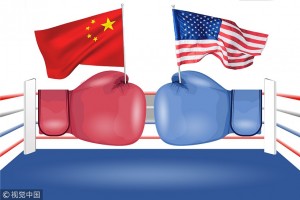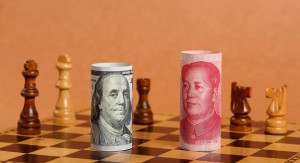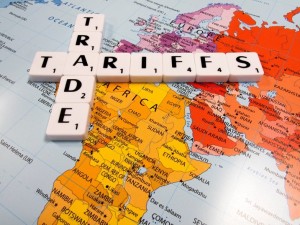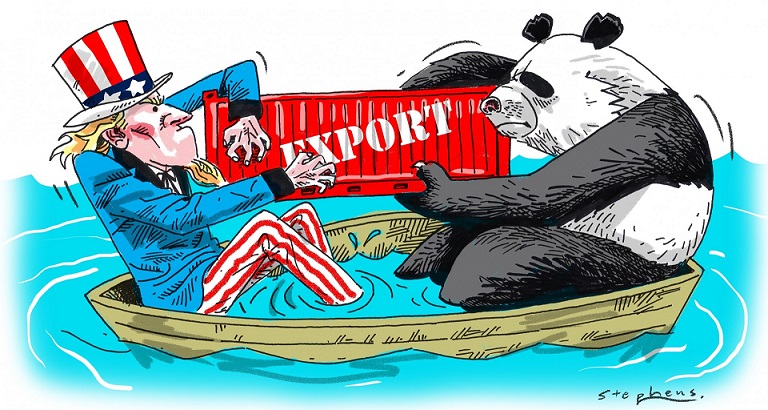US-China Trade War
Latest Episode in Great Power Competition in Asia-Pacific
Tauqeer Ahmed
The logic of ‘Money makes the mare go’ has always been present in global politics. Sans economic resources, states cannot reach the position of power and hegemony. It is, then, no coincidence that the superpower of every age was also an economic powerhouse. In contemporary era, economic strength is a channel for gaining political influence and military might. Fall of Soviet Union is a testament to the notion that without financial muscle, military strength cannot take you far in global power competition. It can be observed that long-term hegemony in international system is more ensured when economic ascent precedes military clout. This happens to be case with the United Kingdom (UK), the United States of America (USA) and China.
The economic rise of China has always been seen by the United States with suspicion. China is the only country that successfully adapted to global capitalist economic system without changing its socialist economic structure and the system of one-party government. China’s economic success makes it a trickier rival of the United States than Russia as the USA has to compete with China not only in political and military fields but also in economic domain. In American view, due to its political, military and economic prowess China is the only power that can replace the United States as a global hegemon.
 American policymakers have always been obsessed with the idea of replacement of the United States as a superpower since the end of the Cold War. With decline in American economy, and emergence of new economic power pivots in the form of EU, China and BRICS, these speculations have intensified. Power transition theory stipulates that after a certain period of time, the structure of international political system changes, therefore international hegemon also changes. Propounded by A.F.K. Organski in his book, World Politics (1958), the theory leads to the long cycle theory of war, and seeks to explain trends between warring states in the past 500 years. The general trend is that a nation achieves hegemonic power and then is challenged by a great power.
American policymakers have always been obsessed with the idea of replacement of the United States as a superpower since the end of the Cold War. With decline in American economy, and emergence of new economic power pivots in the form of EU, China and BRICS, these speculations have intensified. Power transition theory stipulates that after a certain period of time, the structure of international political system changes, therefore international hegemon also changes. Propounded by A.F.K. Organski in his book, World Politics (1958), the theory leads to the long cycle theory of war, and seeks to explain trends between warring states in the past 500 years. The general trend is that a nation achieves hegemonic power and then is challenged by a great power.
Rise to global power is never abrupt. It is a gradual and evolutionary process. No great power has become universal power overnight. Most of superpowers become regional powerhouse first, and then they march on to gain the status of an international power. Britain defeated Napoleon and became a leading European power and that status paved the way for it to become a world superpower. Similarly, with Monroe Doctrine, the United States became the sole hegemon of the Western hemisphere, and this influential position enabled it to rise to the rank of a global superpower when the United Kingdom grew weak in the aftermath of Second World War. One can observe that both the United Kingdom and the United States became largest economies of the world at that time and then transformed into a global hegemon. Industrial Revolution gave comparative advantage to the United Kingdom over other economies whereas weakness of European economies after First World War provided the United States with an opportunity to dominate the international economy.
Similar process can be seen in the rise of China. It has become the hegemon in Asia by challenging American dominance in the Pacific. By claiming South China Sea as its territory, China has captured the heart of the Pacific region. However, before this political and strategic manoeuvring, Beijing surpassed the growth of American economy which was weakened owing mainly to increasing fiscal and trade deficits and global economic recession of 2008-09. The Chinese have successfully given a socialist alternative to American capitalism which exhausted itself in aftermath of Great Recession (2008-09) as Americans themselves supplanted the liberal economist model of the United Kingdom with neoliberal structure of the Bretton Woods system after Second World War.
 Americans sought to contain – even reverse – the economic rise of China because they believed that it will trigger power transition in global arena. The United States launched Asia Pivot policy in 2010 to reassert itself in Asia-Pacific region. It was successful in regaining trust of its allies, and maintenance of presence in the region. America followed this success with Rebalancing Asia policy in 2012 which was directly aimed to contain China, and tip the balance of the region in favour of the United States.
Americans sought to contain – even reverse – the economic rise of China because they believed that it will trigger power transition in global arena. The United States launched Asia Pivot policy in 2010 to reassert itself in Asia-Pacific region. It was successful in regaining trust of its allies, and maintenance of presence in the region. America followed this success with Rebalancing Asia policy in 2012 which was directly aimed to contain China, and tip the balance of the region in favour of the United States.
Under this policy, the United States started to mobilize its allies against China, e.g. Philippines took China to Permanent Court of Arbitration on the issue of South China Sea (SCS), started using ASEAN to put diplomatic pressure on China, and started Freedom of Navigation Operations to challenge Chinese claims over the SCS. Most important of all, the United States started negotiations to create a free trade zone named Trans-Pacific Partnership (TPP) with Asia-Pacific states, minus China, to combat China’s economic influence in the region.
 Things were going well for America until Obama was replaced by Donald Trump as President of the United States. President Trump pulled the United States out of the TPP as he had promised in his election campign. He promulgated his own ‘Indo-Pacific Policy’ to contain China with the help of India as a strategic partner. But the policy has not born any fruit due to lack of concrete support from India. China also divided ASEAN as some member countries like Myanmar, Cambodia and Malaysia started to support Chinese claims. China has also pitched its own free trade zone in the form of Regional Comprehensive Economic Partnership (RCEP) which is likely to be approved by all former TPP members except the United States. So, as ballistic and bombastic President Trump is, he decided to damage economic engine of China with economic attacks.
Things were going well for America until Obama was replaced by Donald Trump as President of the United States. President Trump pulled the United States out of the TPP as he had promised in his election campign. He promulgated his own ‘Indo-Pacific Policy’ to contain China with the help of India as a strategic partner. But the policy has not born any fruit due to lack of concrete support from India. China also divided ASEAN as some member countries like Myanmar, Cambodia and Malaysia started to support Chinese claims. China has also pitched its own free trade zone in the form of Regional Comprehensive Economic Partnership (RCEP) which is likely to be approved by all former TPP members except the United States. So, as ballistic and bombastic President Trump is, he decided to damage economic engine of China with economic attacks.
American economy has been in deficit in trade with other countries, notably China. The trade deficit between the USA and China stood at $419.2 billion in 2018. Trump had promised to eliminate this wide trade deficit. If American trade deficit to China is reduced, it will not only placate American voters but will also slow China’s economic expansion in general, and in Asia-Pacific region in particular.
To compel the Chinese to reduce the trade deficit, President Trump imposed tariffs on Chinese goods imported into the USA. On March 22, 2018, Trump signed a memorandum under Section 301 of the Trade Act of 1974, imposing tariffs of $50 billion on Chinese goods. China responded by imposing tariffs on 128 products it imports from America. Trump administration further announced that it will impose 25 percent tariff on $50 billion in Chinese goods on 15 June 2018. Beijing swiftly retaliated by announcing tariffs on $50 billion in US products. On 17 September 2018, Trump announced 10 percent tariffs on $200 billion in Chinese goods, with a plan to hike the rate to 25 percent at the start of 2019. He threatened additional tariffs on $267 billion in Chinese products if Beijing retaliated. With Chinese plan for $60 billion tariff, trade talks began between the two sides.
With failure of talks, US tariff rates on $200 billion in Chinese goods were increased to 25 percent from 10 percent. China then hiked duties on $60 billion in US goods to as high as 25 percent in June 2019. So far, the US has already slapped tariffs on US$250 billion worth of Chinese products, and has threatened tariffs on US$325 billion more. Chinese tariffs applied exclusively to US goods stand at $110 billion.
Trump and Xi agreed to continue trade negotiations during their meeting on the sidelines of the G20 summit in Japan. Following the truce at the Osaka meet, President Trump has, once again, threatened to slap tariffs on another US$325 billion in Chinese goods. The United States and China recently had high-level trade talks in Shanghai but those were eclipsed by Donald Trump’s surprise decision to escalate the trade war with 10 percent duty on another $300 billion in Chinese goods on 2nd August 2019. Trump’s tariffs now cover virtually all US imports from China.
Even with increasing American pressure, China is not ready to yield. Chinese President Xi Jinping has called for the nation to embark on a new ‘Long March’ and “start all over again”. His pronouncements are being perceived as a clear signal that the Chinese public is being told to prepare for hardships because of the worsening trade tensions. The economy is already slowing and the trade war could trim 0.5 to 1.5 percent from China’s GDP growth, according to estimates by International Monetary Fund. In comparison, the United States is in a better position as the IMF estimated that trade war will trim a modest 0.3 to 0.6 percent from American GDP growth.
Chinese economy is more reliant on the United States than the other way around. American exports to China account for only 0.7 percent of American GDP, whereas Chinese exports to the United States account for 4.5 percent of Chinese GDP. But Chinese are not intimidated by these prospects. Because they know that America is not after their economy but it wants to contain the country in Asia-Pacific region. This is a make-or-break point for China to assert itself as a power at regional as well as global level.
Nevertheless, the situation does not bode well for world economy. The US-China tariff battle is estimated to have affected almost 2.5 percent of global trade. States including Pakistan, which are part of Belt and Road Initiative, can also be a victim because contraction in Chinese economy means decrease in investment in projects under BRI. But, the Chinese will not end their pursuit of regional and global domination. Similarly, the United States will not stop its efforts to contain China at regional and international level.
 Jahangir's World Times First Comprehensive Magazine for students/teachers of competitive exams and general readers as well.
Jahangir's World Times First Comprehensive Magazine for students/teachers of competitive exams and general readers as well.



